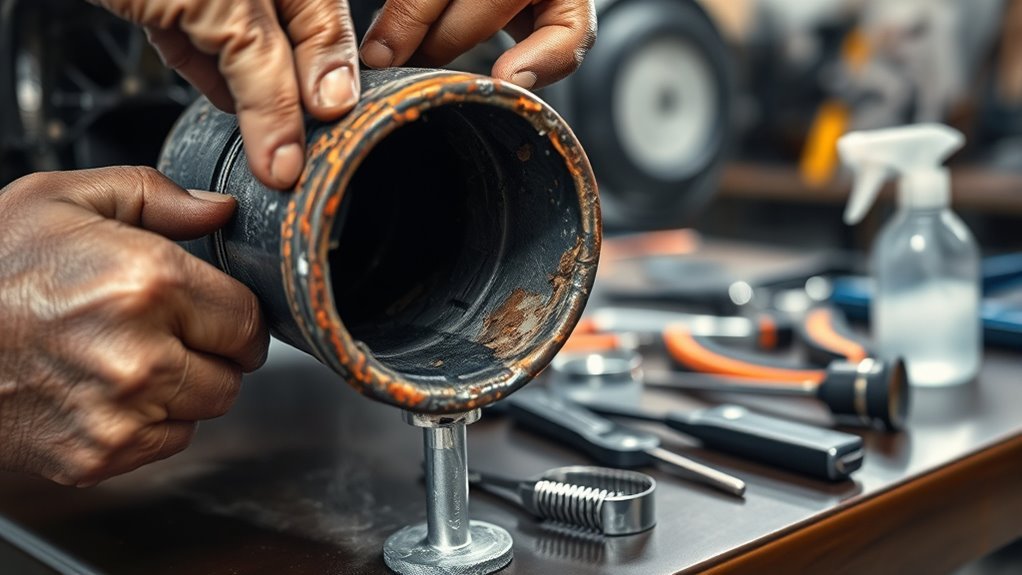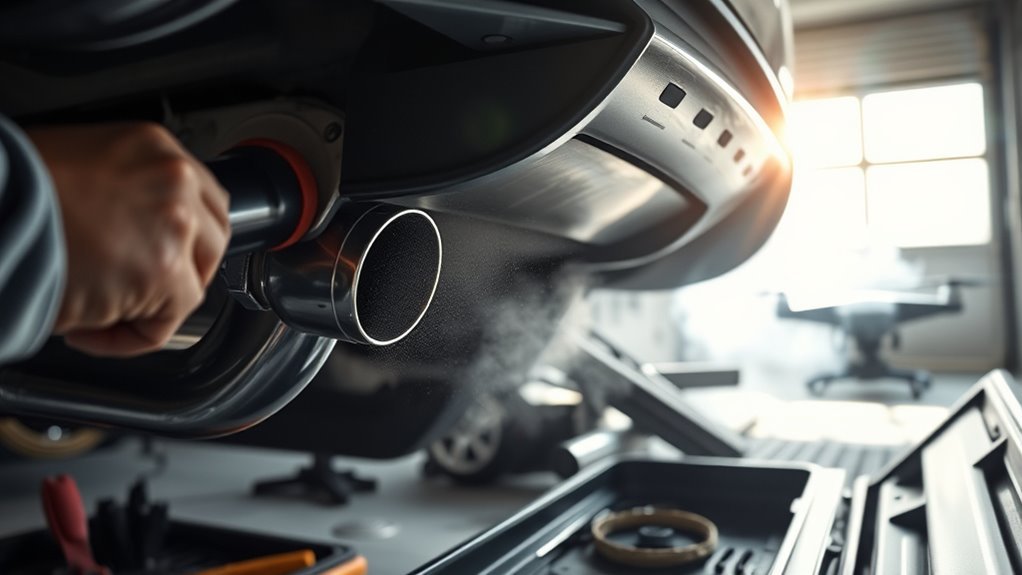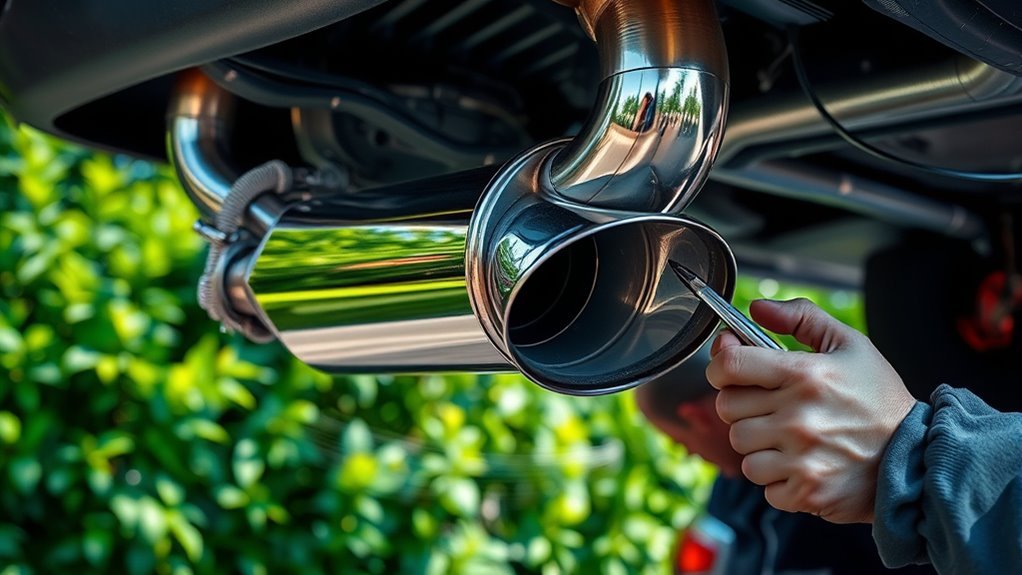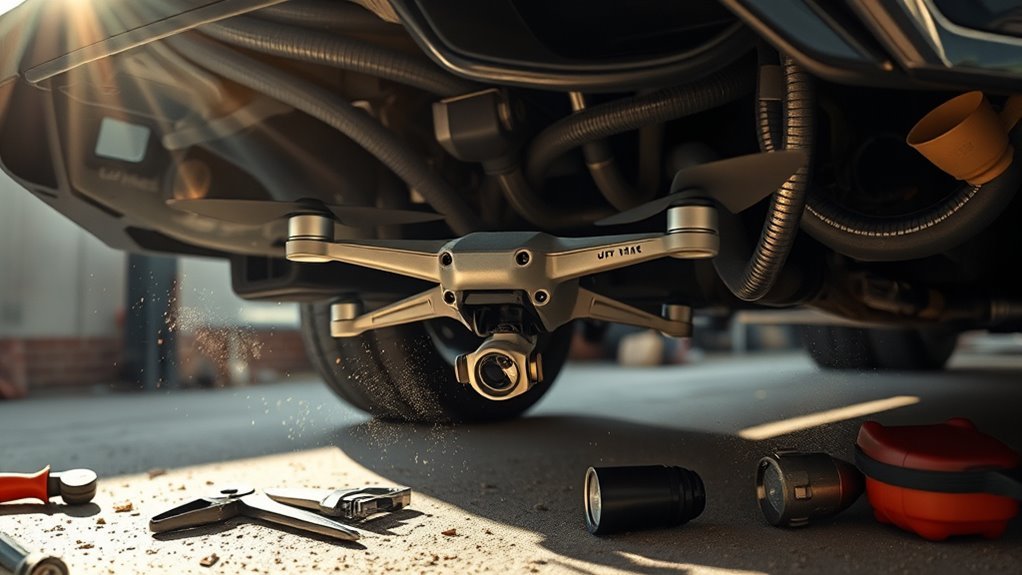If you’re dealing with exhaust drone, start by checking for low-frequency vibrations caused by your exhaust’s pipe length and muffler design. You can reduce drone by adjusting pipe dimensions, replacing or retuning your muffler, and adding resonators tuned to cancel specific frequencies. Sound-absorbing materials around the exhaust can also help dampen persistent hum. If these steps don’t work, a professional mechanic can identify complex issues like resonance or backpressure problems. Explore these methods further to fine-tune your ride’s sound and comfort.
Understanding the Causes of Exhaust Drone

Although exhaust drone might seem like a minor annoyance, it usually indicates specific issues with your vehicle’s exhaust system design or installation that affect cabin noise levels. Drone occurs when certain exhaust frequencies resonate within the vehicle acoustics, creating a persistent low-frequency tone that can be fatiguing. This resonance often arises from poorly tuned pipe lengths, muffler design, or resonator placement, which fail to disrupt the exhaust frequency effectively. When you understand these principles, you can pinpoint why the drone happens—typically, the system amplifies specific harmonics instead of cancelling them out. Addressing these root causes is essential if you want to reclaim your driving freedom, eliminating the intrusive drone by optimizing the exhaust layout for better noise attenuation and smoother acoustic performance inside your cabin.
Identifying Exhaust Drone in Your Vehicle

How can you tell if your vehicle is suffering from exhaust drone? Listen carefully for persistent low-frequency vibrations or humming sounds inside the cabin, especially at steady engine speeds. These drone symptoms usually occur within specific sound frequencies ranging from 50 to 200 Hz. You might notice the noise intensifies during highway cruising or constant RPMs, interfering with your driving experience and sense of freedom. To identify exhaust drone precisely, focus on when the noise appears and its tonal quality—it’s distinct from engine or road noise. Using a smartphone app to measure sound frequencies can help confirm if the noise matches typical drone ranges. Recognizing these signs early lets you take targeted action, preventing long-term discomfort and preserving your vehicle’s performance and your driving enjoyment.
Modifying Exhaust Components to Reduce Drone

When you want to effectively reduce exhaust drone, modifying specific components of your exhaust system is essential. Targeted exhaust modifications can eliminate unwanted frequencies and enhance your ride’s freedom without sacrificing performance. Here are three practical adjustments for your performance upgrades:
- Replace or re-tune the muffler: Select a muffler designed to disrupt drone frequencies or one with variable internal baffling.
- Modify pipe diameter and length: Adjusting these alters resonance characteristics, often shifting drone to less intrusive frequencies.
- Install a high-flow catalytic converter: This can change exhaust flow dynamics, reducing drone while maintaining performance.
Each of these modifications focuses on balancing acoustic control with power gains, giving you a quieter, more enjoyable drive without compromising your vehicle’s spirit.
Using Sound-Absorbing Materials and Resonators
Beyond adjusting your exhaust components, tackling drone effectively often means addressing sound waves directly within the system. You can use sound insulation materials strategically placed around the exhaust to dampen resonance frequencies causing drone. Acoustic panels, designed to absorb specific sound waves, can be integrated inside or near the muffler housing, reducing reflected sound energy that contributes to drone. Additionally, installing resonators tuned to counteract drone frequencies disrupts the formation of standing waves, minimizing vibration transmission. Combining these sound-absorbing materials with resonators optimizes sound control without restricting exhaust flow. By focusing on sound insulation and acoustic treatment, you gain control over unwanted drone, enhancing your driving experience and preserving your freedom on the road. This practical approach targets noise at its source rather than masking it externally.
When to Consult a Professional Mechanic
If you’ve tried basic adjustments and sound-absorbing solutions but still experience persistent drone in your exhaust system, it’s time to contemplate professional assistance. A skilled mechanic uses advanced diagnostic tools to pinpoint the exact cause of the drone, beyond what DIY methods reveal. You should seek mechanic expertise when:
- The drone persists despite muffler or resonator replacements.
- You notice irregular engine performance linked to exhaust flow.
- Exhaust system modifications are needed but require precise tuning.
Consulting a professional guarantees the issue is addressed efficiently, restoring your vehicle’s sound quality and performance. Their technical knowledge and diagnostic equipment can identify subtle problems like pipe resonance or backpressure imbalances, granting you the freedom to enjoy a smooth, drone-free ride.

